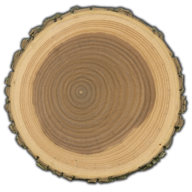White oak?
Leaves are great but if not available there's another way. Prepare a small sample showing end grain, maybe 1/2" square or so including at least 2-3 rings, long enough so it's easy to hold in the fingers or vise. Use a new single-edge razor blade to shave a section smooth - far better than sanding. (If the wood is hard to shave, it's OK to soak it in water first to soften a bit.) Stay away from the pith/juvenile wood and knots.
Look at the rings in the shaved area, note the pore distribution. The large pores are the "earlywood" near the yearly boundary, the small pores in the "late wood". Section 7 in this article has some details on examining the wood.

www.wood-database.com
This shows red and white oak endgrain side-by-side. Don't pay much attention to the color - it can vary widely.
The width of the rings in the radial direction varies somewhat on the growing conditions that year. If interested, you can count the rays from the pith to the bark to see how old that tree was. (One limb from an oak tree here was about 100 years old.)
The vertical lines are the rays that run radially. Oak rays are large compared to some other species.

Note two things:
The tiny latewood pores in oak are arranged in what I like to think of as inverted tornadoes.
The large earlywood pores in red oak are hollow, empty, like soda straws. The earlywood pores in white oak are clogged with what are called tyloses. Under magnification these look a bit like tiny crystals. These clogged pores are one reason white oak is used for whisky barrels and outdoor furniture.
JKJ









